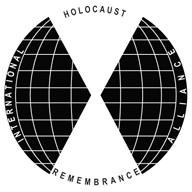“We share a commitment to throw light on the still obscured shadows of the Holocaust.”
-- Declaration of the Stockholm International Forum on the Holocaust
 INTERNATIONAL HOLOCAUST REMEMBRANCE ALLIANCE
INTERNATIONAL HOLOCAUST REMEMBRANCE ALLIANCE
“We share a commitment to throw light on the still obscured shadows of the Holocaust.”
-- Declaration of the Stockholm International Forum on the Holocaust
19 April marks the anniversary of the Warsaw ghetto uprising which began as German troops and police began the liquidation of the ghetto.
As in previous years, the major celebration of the anniversary took place at the Monument to the Ghetto Heroes with the participation of national and local government officials.The event was accompanied by the “Żonkile” (Daffodils) campaign as part of which volunteers walked down the streets of Warsaw and other Polish cities handing out paper daffodils. The daffodils are to symbolise remembrance, respect and hope. They are associated with Marek Edelman, the last surviving leader of the Jewish Combat Organisation before his death in 2009. Edelman used to receive daffodils from an anonymous person on each anniversary of the uprising. He himself laid a bouquet of yellow flowers at the Monument to the Ghetto Heroes each 19 April.
For more information visit the Museum of the History of Polish Jews website
Between July 22 and September 12, 1942, the German authorities deported or murdered around 300,000 Jews in the Warsaw ghetto. The German authorities granted only 35,000 Jews permission to remain in the ghetto, while more than 20,000 Jews remained in the ghetto in hiding. In response to the deportations, on July 28, 1942, several Jewish underground organizations created an armed self-defense unit known as the Jewish Combat Organization (Zydowska Organizacja Bojowa; ZOB). Rough estimates put the size of the ZOB at its formation at around 200 members. The Revisionist Party (right-wing Zionists known as the Betar) formed another resistance organization, the Jewish Military Union (Zydowski Zwiazek Wojskowy; ZZW). Although initially there was tension between the ZOB and the ZZW, both groups decided to work together to oppose German attempts to destroy the ghetto. At the time of the uprising, the ZOB had about 500 fighters in its ranks and the ZZW had about 250.
The German forces intended to begin the operation to liquidate the Warsaw ghetto on April 19, 1943, the eve of Passover. The renewal of deportations was the signal for an armed uprising within the ghetto. Though German forces broke the organized military resistance within days of the beginning of the uprising, individuals and small groups hid or fought the Germans for almost a month.
The Germans deported almost all of the remaining Jews, approximately 42,000, to the Lublin/Majdanek concentration camp, and to the Poniatowa, Trawniki, Budzyn, and Krasnik forced-labor camps. With the exception of a few thousand forced laborers at Budzyn and Krasnik, German SS and police units later murdered almost all of the Warsaw Jews deported to Lublin/Majdanek, Poniatowa, and Trawniki in November 1943 in “Operation Harvest Festival” (Unternehmen Erntefest).
The Warsaw ghetto uprising was the largest and the first urban uprising in Nazi-occupied Europe. The resistance in Warsaw inspired other uprisings in ghettos (e.g., Bialystok and Minsk) and killing centers (Treblinka and Sobibor).